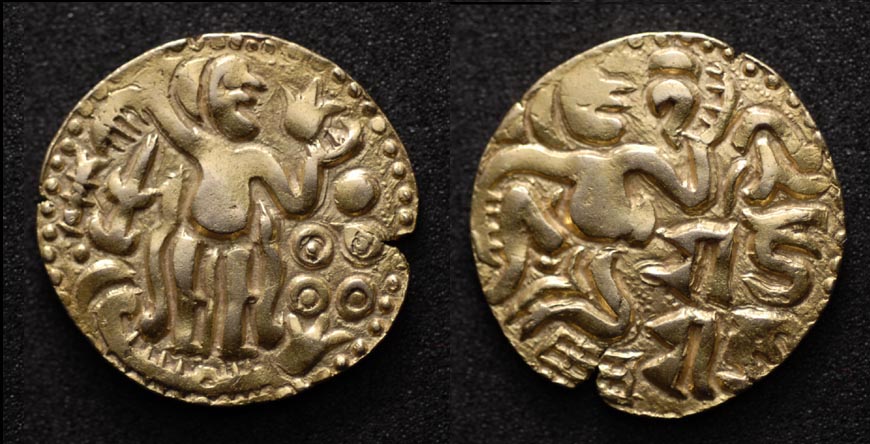Sri Lanka (Ceylon)
Emperor Rajaraja Chola I, Gold
Kahavanu
Mint Place: Sri Lanka
Culture: Indian Chola Dynasty
Ruler: Raja Raja Chola I
Date: 985 to 1014 AD
Denomination: Gold Kahavanu
Diameter: 20mm
Weight: 4.32 grams
Alloy: Gold
Type: Struck
Axis rotation:
120 degrees
References: Codrington #104; Mitchiner #729; Biddulph #5
Obverse: King standing holding Jessamine
flower
Reverse: King seated right, holding upraised sankh shell.
Legend: Devanagari script,
Sri Raja Raja.
(3
lines,
right
obv.)
Rajaraja
Chola
I
(985-1014) aka
Rajajaja
the
Great,
was an emperor
of the Chola Empire. Rajaraja Chola invaded Lanka in 990 AD and
conquered the
northern half. After ruining Anuradhapura, he made Polonnaruwa his
capital on
the island. Rajendra Chola (1014-1044) succeeded in extending
Chola
occupation over the whole island of Lanka in 1018. Lanka regained
independence from the Chola occupation in 1070 under Vijayabahu I
(1055-1110).

The coin's design is similar to Lanka
type copper massas (Octopus man coins) and was later used on a series
of well known anonymous gold kahavanu issued in Sri Lanka. This coin is the official coin of
Rajaraja Chola bearing his name. Anonymous gold coins sometimes
called Rajaraja gold do not bear his name.
Obverse (left): Head represented by an
oval with a projection for
the chin, countersunk inside leaving the eye standing out; Two lines
above chin for nose and mouth. Crown (makuta), a
thick line behind which a triangle. Left arm extended, bent upwards at
elbow and holding a Jessamine flower. Legs short and straight ; dhoti
stiff, line between legs ; the whole standing
on a double
lotus plant Co-joined in the center by a small circle and terminating
on the left in a chank and on the right in a Jessamine flower. To the
left under arm hanging lamp and further to left a standing lamp, tall
with four branches. To write four annulets each with a dot in center
surmounted by ball (filled circle). All in bead circle.
Reverse :
Head and crown as on obverse. Seated king on left facing
right with left arm extended, bent down over leg. Right arm raised
upwards with elbow outwards, and holding a chank. Asana short
with two cross lines. Legend in Devanagari script to right in three
lines Sri - Raja - Raja. All in bead circle.
There are two well-known
varieties of RajaRaja gold coins closely
resembling the Lanka Kahavanuva of type IIIC(1). The type shown
here has four annulets surmounted by ball were struck in or for use in
Lanka where they are mostly found. The type found only in
mainland has a
crescent on top the four annulets on the right of obverse. These
coins are discussed by Biddulph in his 1966 monogram
on Coins of the Cholas, which suggests that the Rajaraja Chola coins
were the prototype to the
"Standing and seated King" series, which Sri Lanka is famous for.
Reference and authentication: http://lakdiva.org/coins/medievalindian/rajaraja_chola_kahavanu_au.html
Mainland example, See: http://www.tnarch.gov.in/epi/ins5.htm
Information from, See
- Ceylon Coins and Currency: H. W. Codrington, Colombo,
1924.
Chapter VII Medieval Indian - Chola Page 84 PL 104
- Coins of the Cholas: C. H. Biddulph, NSI #13, 1966.
- Oriental Coins: Michael Mitchiner,
London, Hawkins Publications, 1978.

